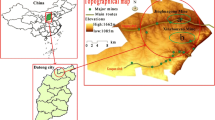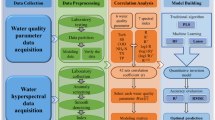Abstract
Remote sensing has been successfully utilized to distinguish and quantify sediment properties in the intertidal environment. Classification approaches of imagery are popular and powerful yet can lead to site- and case-specific results. Such specificity creates challenges for temporal studies. Thus, this paper investigates the use of regression models to quantify sediment properties instead of classifying them. Two regression approaches, namely multiple regression (MR) and support vector regression (SVR), are used in this study for the retrieval of bio-physical variables of intertidal surface sediment of the IJzermonding, a Belgian nature reserve. In the regression analysis, mud content, chlorophyll a concentration, organic matter content, and soil moisture are estimated using radiometric variables of two airborne sensors, namely airborne hyperspectral sensor (AHS) and airborne prism experiment (APEX) and and using field hyperspectral acquisitions by analytical spectral device (ASD). The performance of the two regression approaches is best for the estimation of moisture content. SVR attains the highest accuracy without feature reduction while MR achieves good results when feature reduction is carried out. Sediment property maps are successfully obtained using the models and hyperspectral imagery where SVR used with all bands achieves the best performance. The study also involves the extraction of weights identifying the contribution of each band of the images in the quantification of each sediment property when MR and principal component analysis are used.


















Similar content being viewed by others
References
Adam S (2009) Bio-physical charactarization of sediment stability indicators for mudflats using remote sensing. Ph.D. thesis, Katholieke Universiteit Leuven, Belgium
Adam S, Monbaliu J, Toorman E (2012) Quantification of bio-physico-chemical properties of intertidal sediment at different spatial scales using remote sensing. International Journal of Remote Sensing (2012):37–41
Adam S, Vitse I, Johannsen C, Monbaliu J (2006) Sediment type unsupervised classification of the Molenplaat, Westerschelde estuary, the Netherlands. EARSeL eProceed 5:146–160
Amos C, Feeney T, Sutherland T, Luternauer J (1997) The stability of fine-grained sediments from the Fraser River Delta. Estuar, Coast Shelf Sci 45:507–524
Barille L, Mouget JLL, Meleder V, Rosa P, Jesus B, Barillé L., Méléder V. (2011) Spectral response of benthic diatoms with different sediment backgrounds. Remote Sens Environ 115:1034–1042. doi:10.1016/j.rse.2010.12.008
Baumgardner M, Silva L, Biehl L, Stoner E (1985) Reflectance properties of soils. Adv Agron 38:1–44
Defew E, Tolhurst T, Paterson D (2002) Site-specific features influence sediment stability of intertidal flats. Hydrol Earth Syst Sci 6:971–982
Deronde B, Kempeneers P, Forster R (2006) Imaging spectroscopy as a tool to study sediment characteristics on a tidal sandbank in the Westerschelde. Estuar, Coast Shelf Sci 69:580–590
Diafas I, Panagos P, Montanarella L (2013) Willingness to pay for soil information derived by digital maps: A choice experiment approach. Vadose Zone Journal:1–8
Draper N, Smith H (1998) Applied regression analysis, 3rd edn. Wiley
Drucker H, Burges C, Kaufman L, Smola A, Vapnik N (1996) Support vector regression machines. Advances in Neural Information Processing Systems, MIT press, Cambridge
Flemming BW (2000) A revised textural classification of gravel-free muddy sediments on the basis of ternary diagrams. Cont Shelf Res 20:1125–1137
Gege P, Fries J, Haschberger P, Schotz P, Schwarzer H, Strobl P, Suhr B, Ulbrich G, Vreeling WJ (2009) Calibration facility for airborne imaging spectrometers. {ISPRS} J Photogramm Remote Sens 64:387 – 397. doi:10.1016/j.isprsjprs.2009.01.006. http://www.sciencedirect.com/science/article/pii/S0924271609000124
Giardino A, Ibrahim E, Adam S, Toorman E, Monbaliu J (2009) Hydrodynamics and cohesive sediment transport in the ijzer estuary. Belgium J Waterway, Port Coast, Ocean Eng 135(4):176–184
Hakvoort H, Heymann K, Stein C, Murphy D (1997) In-situ optical measurements of sediment type and phytobenthos of tidal flats: a basis for imaging remote sensing spectroscopy. Deut Hydrographische Z / German J Hydrogr 49:367–373
Hakvoort JHM, Heineke M, Heymann K, Kuhl H, Riethmüller R., Witte G (1998) Optical remote sensing of microphytobenthic biomass: a method to monitor tidal flat erodibility. Senckenberg Marit 29:77–85
Herman P, Middelburg J, Heip C (2001) Benthic community structure and sediment processes on an intertidal flat: results from the ecoflat project. Cont Shelf Res 21:2055–2071
Herrier J.L., Nieuwenhuyse HV (2005) The Flemish coast : life is beautiful !. Nature 2000(2000):13–26
Hoffman M, Adam S, Baert L, Bonte D, Chavatte N, Claus R, De Belder W, De Fre B, Degraer S, De Groote D, Dekoninck W, Desender K, Devos K, Engledow H, Grootaert P, Hardies N, Leliaert F, Maelfait JP, Monbaliu J, Pollet M, Provoost S, Stichelmans E, Toorman E, Van Nieuwenhuyse H, Vercruysse E, Vinckx M, Wittoeck J (2005) Integrated monitoring of nature restoration along ecotones, the example of the Yser estuary. In: Proceedings ’Dunes and Estuaries 2005’ - International conference on Nature Restoration Practices in European Coastal Habitats, Koksijde, Belgium, pp. 191–208
Hunt G (1977) Spectral signatures of particulate minerals in the visible and near infrared. Geophysics 42:501–513
Ibrahim E, Adam S, De Wever A, Govaerts A, Vervoort A, Monbaliu J (2014) Investigating spatial resolutions of imagery for intertidal sediment characterization using geostatistics. Cont Shelf Res 85:117–125
Ibrahim E, Monbaliu J (2009) Supervised classification of hyperspectral images of algased. Report, Vlaams Instituut voor de Zee (VLIZ). prefixwww.vliz.be/imisdocs/publications/238876.pdf
Ibrahim E, Monbaliu J (2013) Site-dependent classes for the classification of intertidal sediments. In: 33rd EARSeL Symposium, Towards Horizon 2020, Matera, Italy, p 773:782
Jolliffe I (1986) Principal component analysis. Springer, New York
Kumar S, Ghosh J, Crawford M (2001) Best-bases feature extraction algorithms for classification of hyperspectral data. IEEE Trans Geosci Remote Sens 39:1368–1379
Lillesand T, Kiefer R (2015) Remote sensing and image interpretation, 7th edn. Wiley
Lundkvist M, Grue M, Friend P, Flindt M (2007) The relative contributions of physical and microbiological factors to cohesive sediment stability. Cont Shelf Res 27:1143–1152
Mitchener H, Torfs H (1996) Erosion of mud/sand mixtures, vol 29, pp 1–25
Murphy R, Tolhrust T, Chapman M, Underwood A (2009) Seasonal distribution of chlorophyll on mudflats in new south wales, Australia measured by field spectrometry and pam fluorometry. Estuar Coast Shelf Sci 84:108–118
Murphy R, Tolhurst T, Chapman M, Underwood A (2005) Estimation of surface chlorophyll a on an emersed mudflat using field spectrometry: accuracy of ratios and derivative-based approaches. Int J Remote Sens 26:1835–1859
Neema D, Shah A, Patel A (1987) A statistical model for light reflection and penetration through sand. Int J Remote Sens 8:1209– 1217
Rainey M, Tyler A, Gilvear D, Bryant R, McDonald P (2003) Mapping intertidal estuarine sediment grain size distributions through airborne remote sensing. Remote Sens Environ 86:480–490
Richter R, Schläpfer D. (2002) Geo-atmospheric processing of airborne imaging spectrometry data. Part 2, Atmospheric/ topographic correction. Int J Remote Sens 23:2631–2649
Smith GM, Thomson A, Möller I., Kromkamp JC (2004) Using hyperspectral imaging for the assessment of mudflat surface stability. J Coast Res 20:1165–1175
Thomson A, Fuller R, Yates M, Brown S, Cox R, Wadsworth R (2003) The use of airborne remote sensing for extensive mapping of intertidal sediments and saltmarshes in eastern England. Int J Remote Sens 24:2717–2737
Van der Wal D, Herman P (2007) Regression-based synergy of optical, shortwave, infrared and microwave remote sensing for monitoring the grain-size of intertidal sediments. Remote Sens Environ 111:89–106
Weidong L, Baret F, Xingfa G, Qingxi T, Lanfen Z, Bing Z (2002) Relating soil surface moisture to reflectance. Remote Sens Environ 81:238–246
Widdows J, Brinsley M (2002) Impact of biotic and abiotic processes on sediment dynamics and the consequences to the structure and functioning of the intertidal zone. J Sea Res 48:143–156
Wright S, Jeffrey S, Mantoura R, Llewellyn C, Bjornland T, Repeat D, Welshmeyer N (1991) Improved HPLC method for the analysis of chlorophylls and carotenoids from marine phytoplankton. Mar Ecol Progress Ser 77:183–196
Yates M, Jones A, McGrorty S, Goss-Custard J (1993) The use of satellite imagery to determine the distribution of intertidal surface sediments of the Wash, England. Estuar, Coast Shelf Sci 36:333–344
Acknowledgments
The field and flight campaigns were supported by the Belgian Science Policy Office in the framework of the STEREO programme, subsidy number SR/00/043, 109, and 072 and subsidy SR/67/167 (BELAIR2013) / SR/XX/169 (BELAIR LITORA).
Author information
Authors and Affiliations
Corresponding author
Additional information
Responsible Editor: Michael Fettweis
This article is part of the Topical Collection on the 13th International Conference on Cohesive Sediment Transport in Leuven, Belgium 7–11 September 2015
Rights and permissions
About this article
Cite this article
Ibrahim, E., Kim, W., Crawford, M. et al. A regression approach to the mapping of bio-physical characteristics of surface sediment using in situ and airborne hyperspectral acquisitions. Ocean Dynamics 67, 299–316 (2017). https://doi.org/10.1007/s10236-016-1024-1
Received:
Accepted:
Published:
Issue Date:
DOI: https://doi.org/10.1007/s10236-016-1024-1




